Physical Address
304 North Cardinal St.
Dorchester Center, MA 02124
Sporadic neurodegenerative disease characterized clinically by progressive asymmetrical involuntary movements, akinetic-rigid parkinsonism, symptoms of upper motor neuron dysfunction (dysarthria, aphasia), and variable dementia; pathologic findings are atrophy of superior frontal lobes, rostral parietal lobes, basal ganglia, and substantia nigra with widespread neuronal and glial tau inclusions
Rare, idiopathic disease
Affects adults in sixth to eighth decades (mean age 65)
No gender or ethnic predominance
Estimated incidence <1 per 100,000 individuals per year
Often nonspecific with unilateral/asymmetrical upper or lower extremity movement abnormalities (stiffness, involuntary jerking, clumsiness, “alien-limb”) or sensory changes
2 to 7 years from initial symptom onset, progression of symptoms to include involvement of previously unaffected limbs, development of apraxia, speech difficulties, hemineglect, and variable cognitive impairment/dementia
Disease progression to death within 6 to 10 years after symptom onset
Patients with a bilateral presentation and dementia have worse prognosis
Noncurable, symptomatic treatment only
CT and MRI scans: asymmetrical cortical atrophy of the superior frontal and parietal regions often in region of central sulcus (“peri-Rolandic”) or Sylvian fissure (“peri-Sylvian”)
Positron emission tomography (PET) scans may demonstrate asymmetrical decreases in glucose metabolism and blood flow in the superior parietal and frontal lobes, thalamus, and striatum
Cortical atrophy tends to involve the superior frontal and rostral parietal regions with relative sparing of the temporal and occipital lobes
Pigment loss in the substantia nigra
Reduced volume of corpus callosum in more rostral levels
Neuronal loss, gliosis, and superficial spongiosis in atrophic cortical regions
“Ballooned” neurons are characteristic:
Medium to large pyramidal neurons with ballooned appearance, loss of usual cytoplasmic staining (“achromasia”), variable vacuolation, and proximal dendrite swelling peripheral nuclear displacement, Nissl substance dispersion
Found in cortical layers III, V, and VI
Can also be found in anterior cingulate gyrus, insular cortex, and amygdala
In substantia nigra: neuronal loss with melanophages, remaining neurons may have intracytoplasmic neurofibrillary tangles
Threadlike processes may be present in the substantia nigra, locus coeruleus, and at the gray-white junctions
Ballooned neurons are strongly immunoreactive for phosphorylated neurofilament protein
Immunoreactivity for phosphorylated tau is most prominent in cell processes of the gray and white matter:
Especially striking in fiber bundles of caudate and putamen
Tau may be demonstrated focally in cytoplasm of cortical neurons, highlighting threadlike processes and oligodendroglial inclusions (“coiled bodies”)
Progressive supranuclear palsy
Parkinson disease
Multiple system atrophy
Pick disease
Alzheimer disease

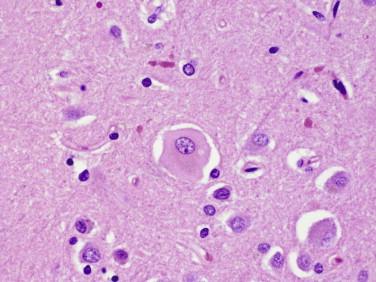
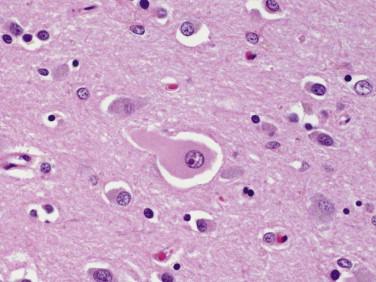

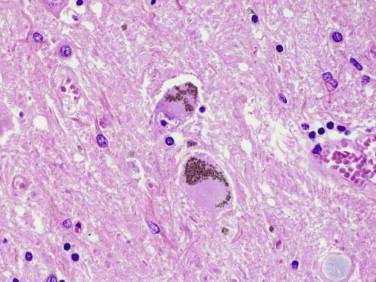
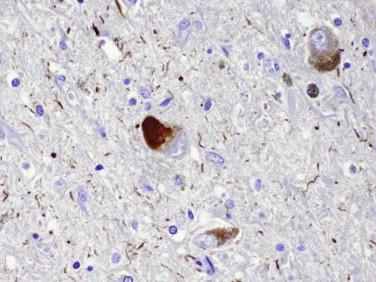
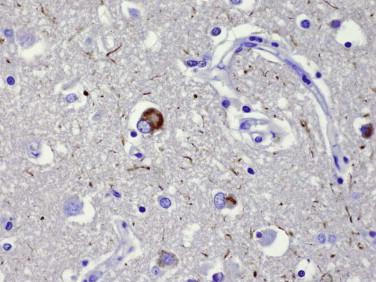
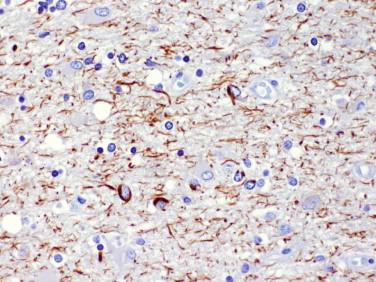
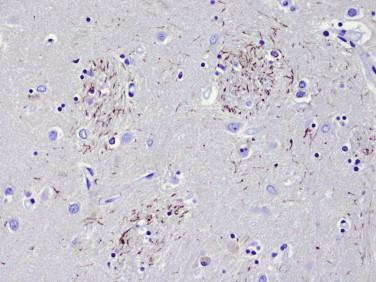
Sporadic multisystem neurodegenerative disease of middle to late adulthood.
Parkinsonism, pseudobulbar palsy, supranuclear ophthalmoplegia, and cognitive decline
Neuronal loss, astrocytosis, and tau-pathology primarily involving basal ganglia, subthalamic nucleus, brain stem, cerebellum, and cerebral cortex
Become a Clinical Tree membership for Full access and enjoy Unlimited articles
If you are a member. Log in here